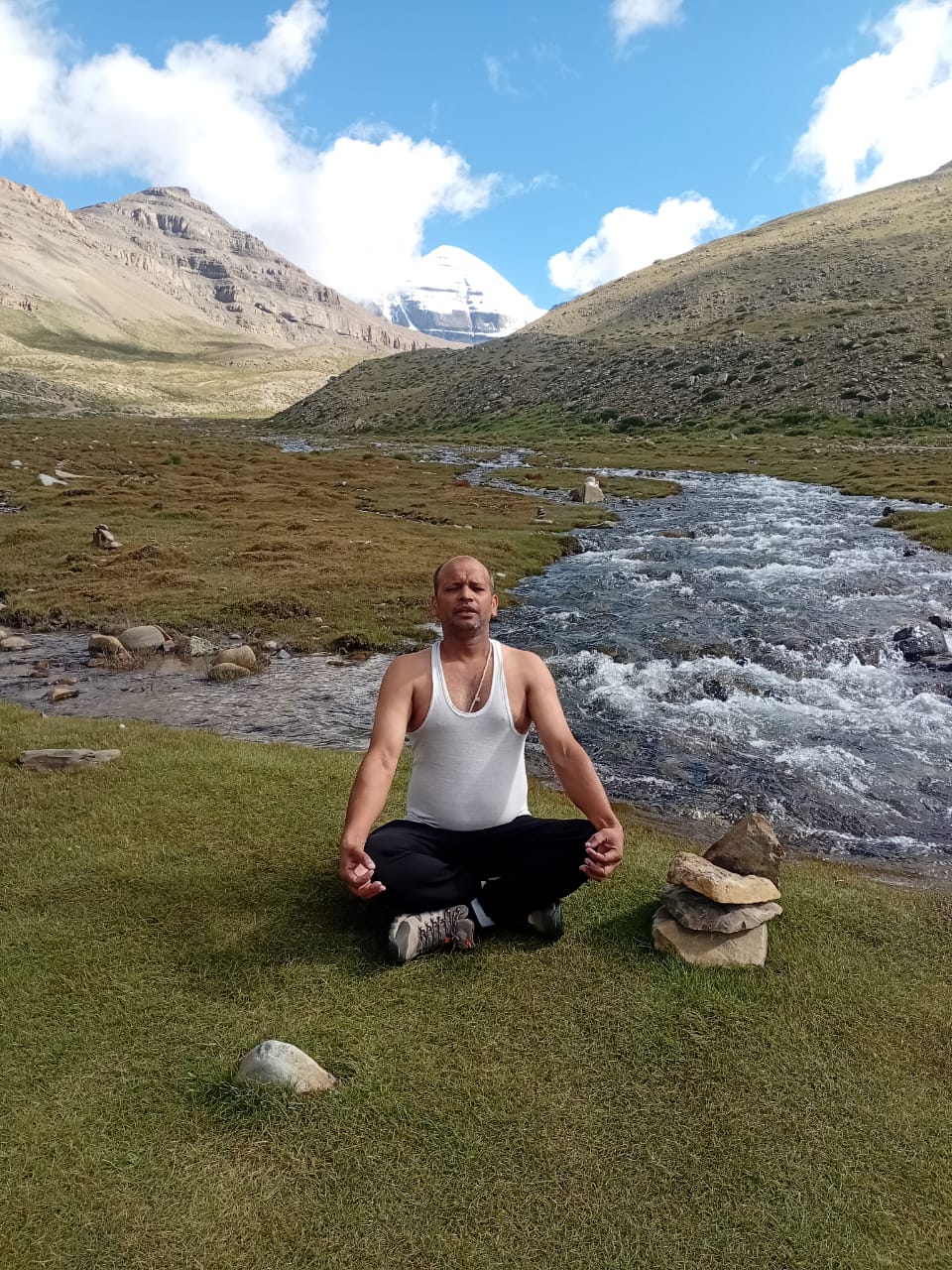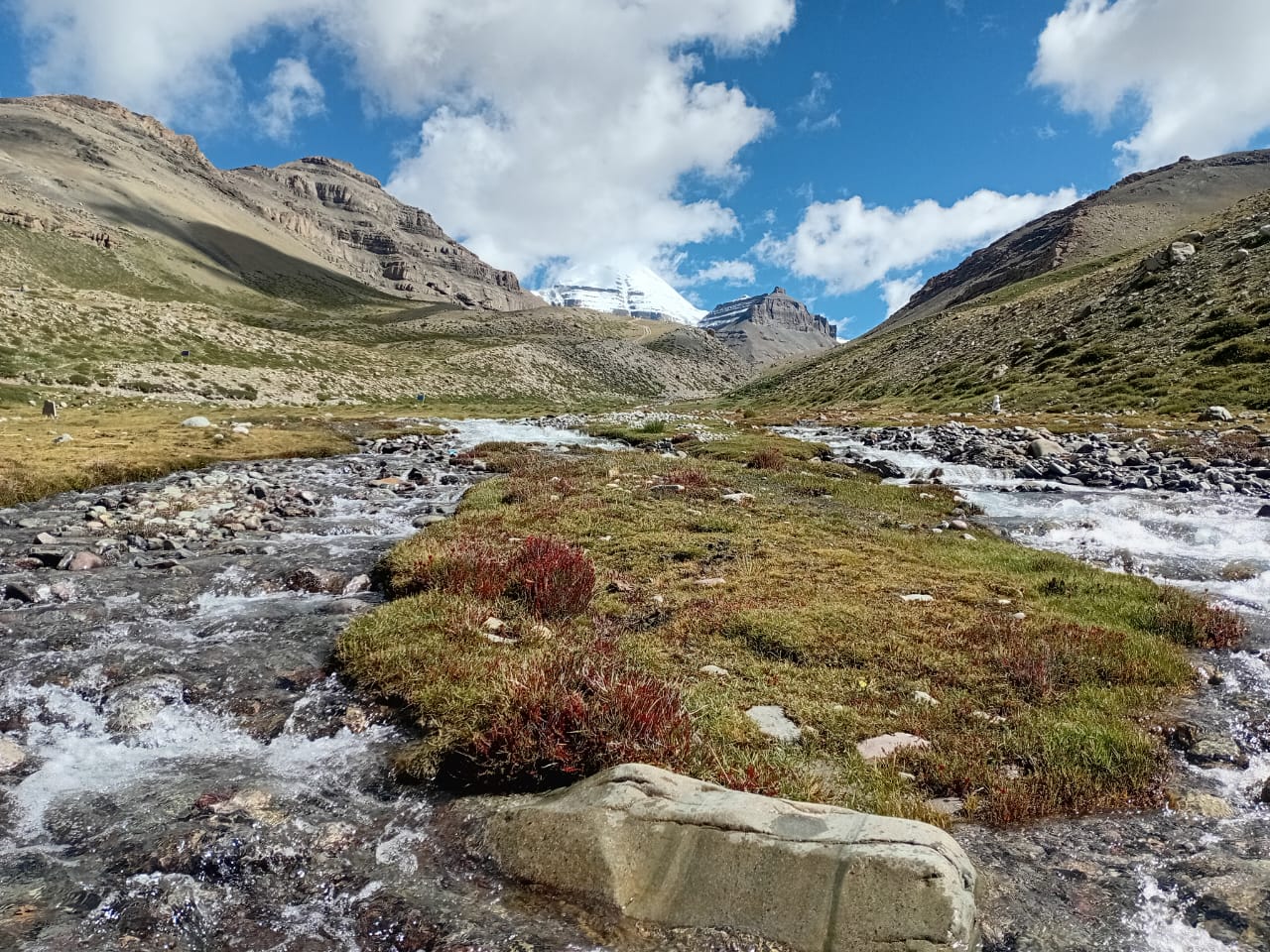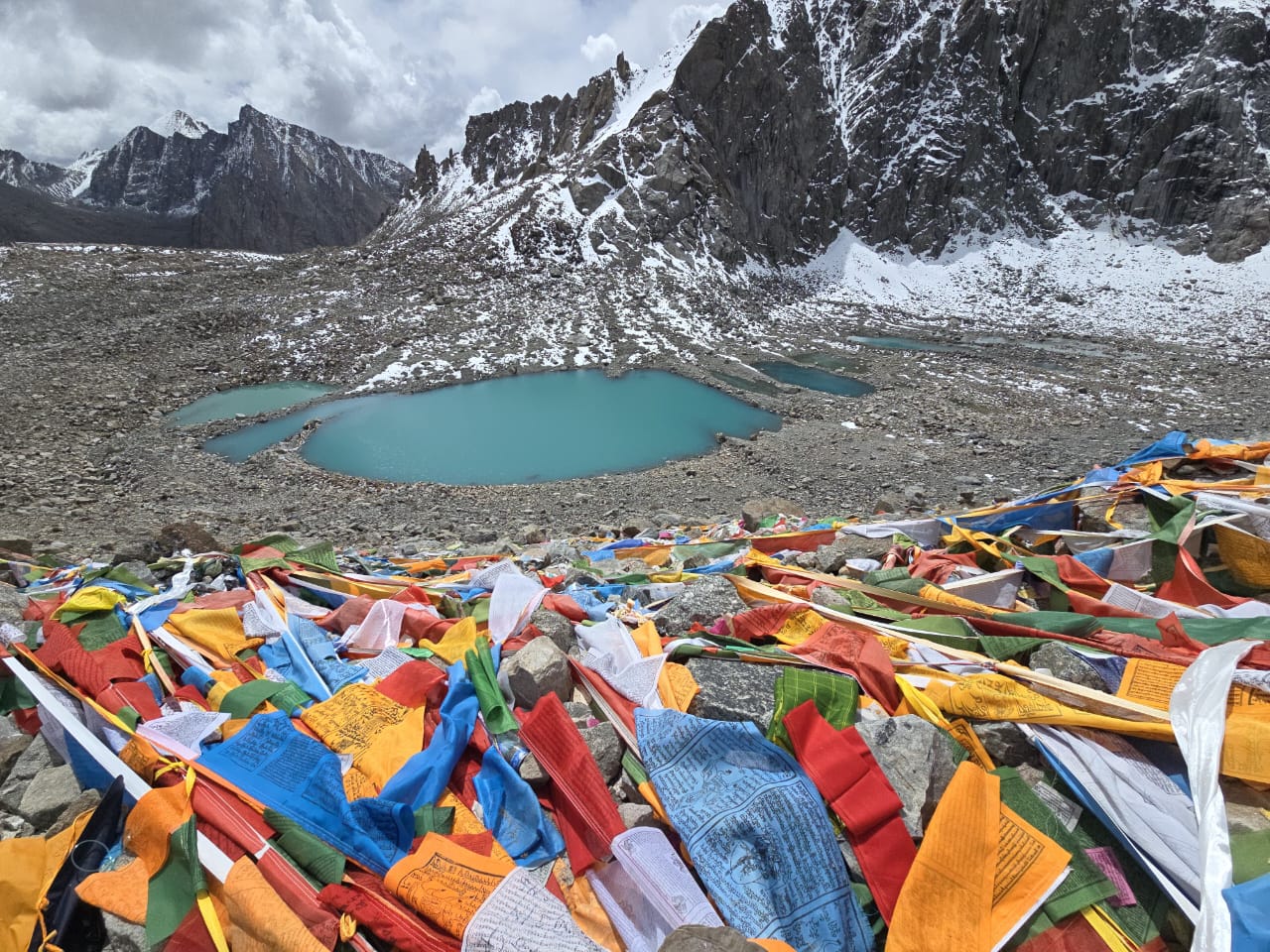The Holy Abode of Lord Shiva
Mount Kailash, standing at 6,638 meters (21,778 ft), is a sacred peak in the Kailash Range, part of the Trans-Himalaya in western Tibet. It lies near the sources of Asia’s four great rivers: the Indus, Sutlej, Brahmaputra, and Karnali (a tributary of the Ganges).
For millions, Kailash is not just a mountain but a living symbol of faith, divine energy, and spirituality. Its snow-clad peak remains unclimbed, revered as the earthly embodiment of Mount Meru—the cosmic center of the universe in Hindu and Buddhist cosmology.
The mountain stands near Lake Manasarovar (a freshwater lake symbolizing purity) and Lake Rakshastal (a saltwater lake symbolizing darkness). Together, they represent cosmic duality and balance.
Spiritual Significance of Mount Kailash
Mount Kailash is unique because it is held sacred by four major religions—Hinduism, Buddhism, Jainism, and Bön—each attaching profound spiritual meaning:
| Religion | Name of Kailash | Belief / Significance |
| Hinduism (Sanatan Dharma) | Kailash Parvat | Abode of Lord Shiva and Goddess Parvati, along with their ganas (divine attendants). |
| Buddhism | Kangri Rinpoche / Gang Tise / Mount Meru | Dwelling place of Demchok (Chakrasamvara) and consort Vajrayogini. Symbolic “Navel of the Earth.” |
| Jainism | Ashtapada | Place where Rishabhanatha, the first Tirthankara, attained enlightenment (moksha). |
| Bon Religion | Yungdrung Gutsek | Sacred to Goddess Sipaimen; founder Tonpa Shenrab is believed to have descended here from heaven. |
 Kailash as the Axis Mundi
Kailash as the Axis Mundi
In many traditions, Mount Kailash is described as the Axis Mundi—the spiritual axis of the Earth, connecting heaven and earth. Its geography forms a natural mandala, with lakes, valleys, hills, and monasteries radiating spiritual energy around the peak.
Pilgrims perform the Kailash Yatra (circumambulation or Parikrama/Kora), a 52 km trek around the mountain. It is believed that a single circumambulation washes away the sins of a lifetime, while 108 circumambulations bring salvation.
Sacred Sites Around Mount Kailash
A pilgrimage to Kailash is incomplete without visiting its nearby holy sites:
Yam Dwar (Tarboche) – Gateway to Kailash Parikrama, considered the “Gate of Yama (God of Death).”
Lake Manasarovar – The highest freshwater lake (4,590 m), revered as the “Lake of the Gods,” symbolizing purity and enlightenment.
Rakshastal – The “Lake of Ravana,” symbolizing darkness and negative energy.
Saptarishi Caves – Said to have sheltered the seven sages during meditation.
Gauri Kund – Sacred lake where Goddess Parvati is believed to have bathed.
Ashtapad – A Jain pilgrimage site where Lord Rishabhanatha attained enlightenment.
Nandi Parvat – A mountain resembling Lord Shiva’s divine bull, symbolizing devotion and guardianship.

Shivasthal – Pilgrims leave offerings here, symbolizing renunciation and rebirth.
Jokhang Temple, Lhasa – Tibet’s holiest temple, holding a life-size statue of young Buddha.
Trithapuri Monastery & Hot Springs – Associated with Guru Rinpoche, visited for healing and meditation.
The Sacred Kora (Parikrama)
Outer Kora (52 km): Standard circumambulation route, usually completed in three days.
Inner Kora: Advanced pilgrimage routes (e.g., Nandi Kora, Dakini Path, Nangkor), traditionally attempted only after completing 12 Outer Koras or during the Tibetan Horse Year.
Spiral Kora: A symbolic, multi-layered pilgrimage combining four routes named after jewels (Sapphire, Emerald, Ruby, Golden), representing deeper spiritual progression.
Extended Koras:
Barkor – Linking sacred lakes and hot springs.
Takor – Extending to the Guge Kingdom.
Outermost Kora – Covering 1,920 km, linking Kailash to ancient pilgrimage routes.

7 Best Highlights of Kailash Manasarovar
While the holy kora (circumambulation) around Mount Kailash is the centerpiece of most journeys, the region has much more to offer. Below are the 7 best highlights of Kailash Manasarovar to inspire your next visit.
No.1: Trek the Sacred Kora around Mount Kailash
The 52-kilometer kora around Mount Kailash is one of the most powerful pilgrimages in the world. For pilgrims, it is believed to cleanse a lifetime of sins, and for travelers, it’s a once-in-a-lifetime adventure.
The trek usually takes three days, beginning at Darchen. The first stop is Drirapuk Monastery, followed by the challenging climb over Dolma La Pass (5,630 m), the highest point on the route. The journey concludes at Zutulpuk Monastery before returning to Darchen.
This trek is physically demanding yet spiritually uplifting, offering jaw-dropping views of Mount Kailash from every angle.
No.2: Perform the Yatra around Lake Manasarovar
At an altitude of 4,590 meters, Lake Manasarovar is one of the holiest lakes in Asia. Hindus believe it was first created in the mind of Lord Shiva, while Buddhists consider it the site where Maya Devi conceived Buddha.
The parikrama or kora around the lake covers about 100 kilometers and usually takes five days to complete. Pilgrims bathe in its waters or drink from the lake, believing it purifies the body and soul. Along the way, you’ll pass by stunning monasteries and witness breathtaking reflections of Mount Kailash in the lake’s crystal waters.
No.3: Meet Pilgrims from Around the World
One of the most enriching aspects of the Kailash journey is meeting pilgrims along the trail. Many perform prostrations—lying flat on the ground with each step—in deep devotion.
You’ll encounter Tibetans, Indians, Nepalis, and pilgrims from across the globe, each carrying their own stories of faith and determination. Conversations with them offer profound insights into spirituality, humility, and resilience.
No.4: Explore Five Monasteries around Mount Kailash
Surrounding Mount Kailash are five remarkable monasteries, each with unique legends and sacred relics:
-
Chuku Monastery – Home to mystical relics like the Chuku statue, the Conch Shell, and the Teapot.
-
Drirapuk Monastery – Famous for its row of white stupas and as the first overnight stop during the kora.
-
Zutulpuk Monastery – Built around Milarepa’s sacred cave, featuring his hand and footprints.
-
Selung Monastery – A meditation retreat for monks, located along the inner kora.
-
Gyangzha Monastery – The oldest and most revered monastery in western Tibet.
Visiting these gompas connects you to centuries of Tibetan spiritual heritage.
No.5: Witness the Kailash Saga Dawa Festival
If you travel in late spring, don’t miss the Saga Dawa Festival, one of Tibet’s most important religious celebrations. Held in the fourth month of the Tibetan calendar, it honors the birth, enlightenment, and death of Buddha.
The highlight is the raising of the giant prayer flag pole at Tarboche. Monks and locals gather in vibrant ceremonies, chanting prayers and hanging new prayer flags. The next festival will be held on June 11, 2025—an unforgettable chance to immerse yourself in Tibetan culture.
No.6: Admire the Kangkyam Glacier
Along the Kailash kora, you can take a short detour to visit the Kangkyam Glacier, descending from the north face of Mount Kailash. It is one of the few moving glaciers in the world and offers extraordinary views of the towering mountain walls.
The hike takes about two hours from Drirapuk Monastery and rewards visitors with serene beauty and the raw power of nature.
No.7: Relax at Tirthapuri Hot Springs
After completing the grueling kora, pilgrims head to Tirthapuri Monastery, located near the Sutlej River. Its natural hot springs are believed to have healing properties and provide perfect relief for tired muscles.
The monastery is also home to sacred footprints of Guru Rinpoche (Padmasambhava), making it both a spiritual and rejuvenating stop.
The Four Sacred Rivers of Kailash
From its four faces flow Asia’s greatest rivers, each associated with a sacred animal:
Brahmaputra (Horse River) – From the east face, flowing through Tibet, India, and Bangladesh.
Sutlej (Elephant River) – From the west face, passing through Tibet, India, and Pakistan.
Indus (Lion River) – From the north face, South Asia’s longest river.
Karnali (Peacock River) – From the south face, Nepal’s longest river, joining the Ganges.
Thus, Kailash is both a spiritual and hydrological lifeline of Asia.
Mysteries and Fascinating Facts
Despite centuries of fascination, Kailash remains shrouded in mystery. Some of the most remarkable beliefs and enigmas include:
Unclimbed Summit – No mountaineer has ever reached the top; climbing is forbidden out of reverence.
Mysterious Deaths – Expeditions attempting to climb faced tragic fates.
Cross Mark – A unique cross-like groove said to result from ancient spiritual battles.
Pyramid Theory – Some suggest Kailash is a colossal pyramid surrounded by smaller ones.
Magnetic Energy – Legends claim it emits powerful magnetic fields.
Geographic Centrality – Distances from Kailash to sacred sites, such as Stonehenge and the North Pole, align mystically.
Global Energy Grid – Believed to be part of a spiritual network with other sacred sites.
Time Distortion – Pilgrims report accelerated aging of hair and nails.
Prototype of Mount Meru – Seen as Earth’s counterpart of the cosmic mountain.
Mansarovar & Rakshastal – Twin lakes representing cosmic duality (light and darkness).
Shiva’s Face – Shadows on the slopes resemble Lord Shiva’s visage.
OM Symbol – Natural ridges form the sacred ॐ symbol.
Wisdom Reservoir – Believed to store divine spiritual knowledge.
Rivers of Life – Source of four great rivers nourishing civilizations.
Hidden Cities – Legends claim Shambhala and Agartha lie beneath the Kailash range.

Conclusion
Mount Kailash is more than a geographical landmark—it is a cosmic symbol of spirituality, mystery, and divine presence. Revered across four major faiths, it stands as a sacred bridge between human devotion and the eternal divine. With its sacred lakes, pilgrimage routes, and profound mysteries, Mount Kailash continues to inspire awe as one of the world’s holiest and most enigmatic mountains.
Mount Kailash Mansarovar Yatra – Possible Routes from Nepal & Tibet
Mount Kailash (6,638 m) and Lake Manasarovar (4,590 m) are among the most sacred pilgrimage destinations in Asia. Devotees from around the world undertake this journey—known as the Kailash Mansarovar Yatra—to perform the 52 km Kora (circumambulation) of Mount Kailash and to take a holy dip in Lake Manasarovar.
There are multiple routes to reach Kailash, each with unique cultural and geographical experiences.
1. Kailash Yatra via Kerung (Rasuwa-Gyirong Border) – Most Popular Route
📅 Duration: 14 Days
🚩 Entry Point: Kerung (Rasuwa-Gadhi, Nepal–Tibet Border)
✅ Best for: First-time pilgrims, safe acclimatization, comfortable road journey.
Highlights:
-
Scenic drive through Langtang National Park.
-
Overnight stays at Kerung, Saga, Manasarovar, and Darchen.
-
3-day Kailash Parikrama (Darchen → Dirapuk → Dolma-La Pass → Zutulpuk → Darchen).
-
Rituals at Lake Manasarovar and holy bath.
Short Itinerary:
-
Day 01–02: Arrival in Kathmandu, sightseeing (Pashupatinath, Boudhanath, Patan).
-
Day 03–04: Drive Kathmandu → Ghatte Khola → Kerung.
-
Day 05–06: Kerung → Saga (acclimatization).
-
Day 07–08: Saga → Lake Manasarovar → Darchen.
-
Day 09–11: Kailash Kora (Dirapuk → Dolma-La Pass → Zutulpuk).
-
Day 12–14: Return via Saga → Kerung → Kathmandu.
2. Kailash Yatra via Kodari Border (Tatopani – Zhangmu Route)
📅 Duration: 13 Days
🚩 Entry Point: Kodari Border (Sindhupalchok, Nepal–Tibet)
✅ Best for: Shorter drive, historical trade route (Silk Road).
Highlights:
-
Ancient Kodari–Zhangmu route (traditional Nepal–Tibet trade link).
-
Bhotekoshi River Valley and Himalayan passes.
-
Quick access to Nyalam and Saga before Manasarovar.
-
Same 3-day Kailash Kora circuit.
Short Itinerary:
-
Day 01–02: Kathmandu arrival, temples visit (Pashupatinath, Jal Narayan).
-
Day 03–04: Drive Kathmandu → Kodari → Nyalam.
-
Day 05–06: Nyalam → Saga (rest & acclimatization).
-
Day 07–08: Saga → Lake Manasarovar → Darchen.
-
Day 09–11: Kailash Kora (Dirapuk → Zutulpuk).
-
Day 12–13: Return via Saga → Kodari → Kathmandu.
3. Kailash Yatra via Mustang (Upper Mustang – Lomanthang Route)
📅 Duration: 15 Days
🚩 Entry Point: Korala Border (Upper Mustang, Nepal–Tibet Border)
✅ Best for: Adventure seekers, cultural immersion, less crowded route.
Highlights:
-
Fly or drive to Pokhara and Jomsom.
-
Explore Upper Mustang’s Tibetan Buddhist culture (Lo Manthang, ancient caves, monasteries).
-
Cross Korala border into Tibet.
-
Unique Himalayan landscapes and Tibetan plateau.
-
Follows the same Kora at Kailash.
Short Itinerary:
-
Day 01–03: Kathmandu sightseeing, fly/drive to Pokhara–Jomsom–Lo Manthang.
-
Day 04–06: Explore Mustang & cross Korala Border to Tibet.
-
Day 07–08: Drive Korala → Saga → Lake Manasarovar.
-
Day 09–11: Kailash Kora (Dirapuk → Zutulpuk).
-
Day 12–15: Return via Saga → Mustang → Kathmandu.
4. Kailash Yatra via Lhasa (Fly-in/Fly-out Route)
📅 Duration: 12 Days
🚩 Entry Point: Lhasa, Tibet (via Kathmandu or Chengdu flight)
✅ Best for: Comfortable journey, luxury options, cultural Tibet experience.
Highlights:
-
Scenic flight Kathmandu → Lhasa (or Chengdu → Lhasa).
-
Sightseeing in Lhasa: Potala Palace, Jokhang Temple, Barkhor Street.
-
Drive Lhasa → Shigatse → Saga → Lake Manasarovar.
-
Kailash Parikrama (3 days).
-
Fly back from Lhasa.
Short Itinerary:
-
Day 01–03: Fly Kathmandu → Lhasa, acclimatize, explore Potala Palace & monasteries.
-
Day 04–06: Drive Lhasa → Shigatse → Saga.
-
Day 07–08: Saga → Lake Manasarovar → Darchen.
-
Day 09–11: Kailash Kora (Dirapuk → Zutulpuk).
-
Day 12: Return drive → Fly back from Lhasa → Kathmandu.
Comparison of Routes
| Route | Entry Point | Duration | Best For | Highlights |
|---|---|---|---|---|
| Kerung | Rasuwa-Gadhi | 14 Days | First-time pilgrims, safe acclimatization | Scenic Langtang route, gradual altitude gain |
| Kodari | Tatopani (Sindhupalchok) | 13 Days | Traditional & historic route | Bhotekoshi Valley, Nyalam, Silk Road |
| Mustang | Korala Border (Upper Mustang) | 15 Days | Adventure & culture | Lo Manthang, Tibetan Buddhism, remote access |
| Lhasa | Flight via Tibet | 12 Days | Comfort & luxury | Potala Palace, Shigatse, cultural Tibet |
Each route ultimately leads to Mount Kailash Kora and Lake Manasarovar rituals, but the approach, cultural experience, and duration differ. Pilgrims can choose based on their physical capacity, spiritual preference, and adventure interest.
